


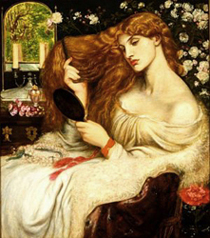

Art in Willa Cather's Fiction
Coming, Aphrodite! (1920)

The extent to which Willa Cather was interested in and influenced by art has been carefully documented by Polly P. Duryea in her 1993 dissertation Paintings and Drawings in Willa Cather's Prose: A Catalogue Raisonne. To facilitate appreciation of Cather's art allusions, I have gathered together here images of the art identified by Duryea and selected quotations and commentary from her dissertation.
Cather's "Coming, Aphrodite!" [alternate title: "Coming, Eden Bower"] is a novella about the development of two artists--the painter Don Hedger and the singer Eden Bower--whose paths cross for a short time in their separate pursuits of art and career goals.

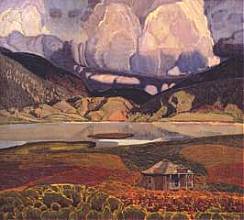

Ernest L. Blumenschein, (left) The Lake, 1927 and (right) Dance at Taos, 1923
- "Blumenschein painted the New Mexico landscape and its people. Presumably Cather had him in mind when she created her character, Don Hedger. He portrayed Indian-peoples in a painting called Rain Spirits (1920); Hedger was 'among the very moderns' to exhibit at 'V--'s' [perhaps Vollard's, the avant-garde dealer's gallery] in Paris ('Coming, Eden Bower!' Uncle Valentine 165)," according to Duryea.
- Dance at Taos "exemplifies the style proposed by Don Hedger," according to Duryea.
- Cather:
- "In the studio Hedger got out his sketches, but to Miss Bower, whose favourite pictures were Christ Before Pilate and a redhaired Magdalen of Henner, these landscapes were not at all beautiful, and they gave her no idea of any country whatsoever" ("Coming, Eden Bower!"/"Coming, Aphrodite!" [1920, C54].

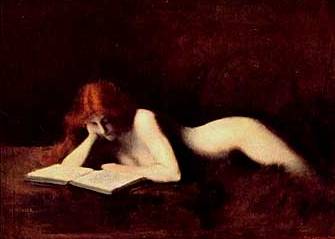
Jean Jacques Henner, The Reader, 19th century.
- Cather:
- Miss Bower['s] . . . favourite pictures were Christ Before Pilate and a redhaired Magdalen of Henner . . ." ("Coming, Eden Bower!"/"Coming, Aphrodite!" [1920, C54]).
- It is unclear whether this is Henner's "Magdalene Reading," but it is the only Henner I could find online that resembles Duryea's description below. It is also similar (reclining pose, red hair, nudity, and book) to one of the standard ways of portraying Mary Magdalene, as can be seen in the Seghers' image below. Duryea also notes that Henner painted other conventional images of the senuous Magdalene common in the European art tradition, images such as Magdalene at the Tomb, Magdalene Kneeling, Magdalene Reclining, Magdalene in Meditation, Magdalene Reading.

Gerard Seghers, Repentant Magdalene (date unknown)
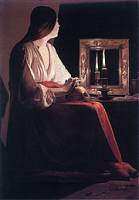
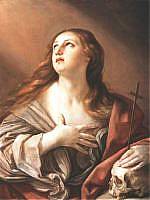

(Left) Georges de La Tour, The Penitent Magdalene, 1638-43
(Middle) Guido Reni, The Penitent Magdalene, 1635
(Right) Titian (Tiziano Vecellio), St. Mary Magdalene, ca. 1530-35.
- "The Penitent Magadalene" was another piously erotic motif in European art and typically featured the upward gaze and hand-on-chest gesture. Duryea believes Cather was familiar with the La Tour and the Reni "Magdalene" paintings.
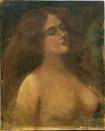

(Left) Jean Jacques Henner, Nude Bust of a Red Head (19th century)
(Right) Dante Gabriel Rossetti, Beata Beatrix ca. 1864-70
- Henner's red-head image would seem to reflect the secular sensuousness of his "The Penitent Magdalene"as decribed by Duryea (see below), but it is unclear if this red-head is Magdalene. The red hair and raised head/closed eyes of inward ecstasy in Henner's image are also reminiscent of Rossetti's Pre-Raphaelite redheads, particularly if the beatific image of Rossetti's Beatrice is combined with the senuosity of his heavenly "Blessed Damozel." Cather was familiar with Rossetti's work.
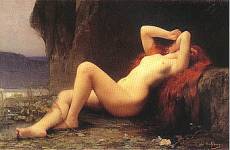

(Left) Jules Lefebvre, Mary Magdalen in the Grotto [Cave], 1876
(Right) Titian (Tiziano Vecccellio), Venus of Urbino, 1538.
- According to Duryea, "Henner's painting of The Penitent Magdalen was strongly influenced by the Venetians. His Titianesque Magdalen is nearly nude but bears little relationship to Christ's penitent follower except in her allure and abundant red hair. The Magdalen's generous bosom and smoldering gaze recalls another courtesan--Manet's Olympia. Like his contemporary Henner, Manet borrowed elements from a famous Venetian's painting, that of the Venus of Urbino by Titian. In comparing the French pictures, however, Henner's Magdalen rests easily in a sumptuous Venetian landscape while Manet's Olympia in a bordello is much more shocking. Moreover, Henner's Magdalen lacks Olympia's provocative stare."
- The nude pose of Lefebvre's Magdalene clearly links this tradition back to Titian's famous mythic courtesan. Another Magdalene art tradition presents her as more pious and clothed, but Duryea's documentation seems to refer more to the "sensuous sinner" tradition. In addition, the Venus (Aphrodite) connection might suggest why Cather later changed the title of this novella to "Coming, Aphrodite."

Albrecht Dürer, Christ before Pilate for the First Time, early 15th Century.
- Cather:
- "Miss Bower['s] . . . favorite pictures were Christ Before Pilate and a redhaired Magdalen of Henner . . ." ("Coming, Aphrodite!" Youth and the Bright Medusa 27, c. 1920).


Dante Gabriel Rossetti, Lady Lilith, 1868.
- According to Duryea, "Ancient texts say that Lilith was Adam's first, serpentine wife before God gave him Eve. Lilith is the powerful narrator in another of D. G. Rossetti's poems, 'Eden Bower.' Elements of Rossetti's poem and his Lilith as femme fatale resurface in Cather's short story 'Coming, Eden Bower!"
- Here are copies of Rossetti's poems "Lilith" and "Eden Bower."


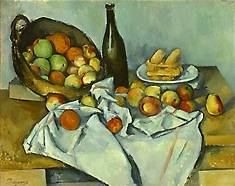
Paul Cézanne, (left) A Blue Vase, 1908 and (right) Basket of Apples, ca. 1885
- According to Duryea, "Cather never wrote about Cézanne, but she knew his work from the Luxembourg Museum" and he "probably characterized Cather's unnamed and abbreviated artist, 'C--,' with whom Don Hedger had painted in the South of France" ("Coming, Eden Bower!" [Crane C54]).
- Duryea also notes that Cezanne's painting Le Vase Bleu [The Blue Vase] relates to Cather's discussion of Ántonia. According to Sergeant, Cather said, "'I want my new heroine to be like this--like a rare object in the middle of a table, which one may examine from all sides.' She [Cather] moved the lamp so that light streamed brightly down on my Taormina jar, with its glazed orange and blue design" (Sergeant p. 139, quoted in 1916).
- Thinking of Cezanne's painting Pommes et Oranges [Apples and Oranges], Duryea recalls "Cather's own Cézannesque words in 1921": "Just as if I put here on the table a green vase, and beside it a yellow orange. Now, those two things affect each other. Side by side, they produce a reaction which neither of them will produce alone. Why should I try to say anything clever, or by any colorful rhetoric detract attention from those two objects, the relation they have to each other and the effect they have upon each other? I want the reader to see the orange and the vase--beyond that, I am out of it. Mere cleverness must go" (Bookman (3 May 1921); WCP 23).
- Another Cézannesque statement by Cather:
- "What I always want to do is to make the 'writing' count for less and less and the people for more. In this new novel I'm trying to cut out all analysis, observation, description, even the picture-making quality, in order to make things and people tell their own story simply by juxtaposition, without any persuasion or explanation on my part."

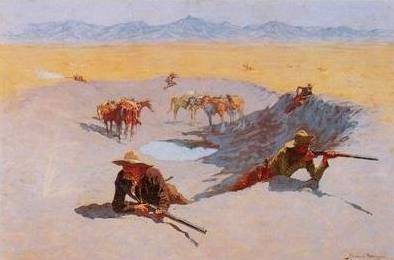
Frederic S. Remington, Fight for the Waterhole, 1901
- Cather:
- ". . . Remington, then a great man in American art, happened to see [Hedger's pastels] and generously tried to push [them]" (Smart Set 92 (Aug. 1920): 3-25 [Crane C54]).
- Frederic Remington was well-known for his "cowboys from the West and southwest." "At the Cather Childhood Home in Red Cloud, a framed Remington print of his Fight for the Waterhole hangs on a downstairs wall (1903, illus. in Arts Magazine 66.3 (21 Nov. 1991): 21)," according to Duryea.

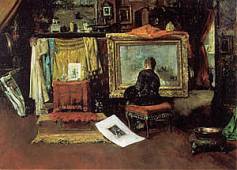

William Merrit Chase, (left) Tenth Street Studio, 1881-2 and (right) Tenth Street Studio, 1881-1910
- "The figures in [Chases's] painting show an affinity to those in the story by Cather. Chase opened his Tenth Street Studio, which was for public events, on Central Park-West Side. The location was near Connie Ayshire's fictional apartment. Cather evidently knew of this painting or versions of it. . . . ," according to Duryea.
- According to Duryea, "Cather again refers to Lucien Simon in 'Coming, Aphrodite,' which was also published as 'Coming, Eden Bower!: A Complete Novelette' in the Smart Set 92 (Aug. 1920): 3-25 [Crane C54]." Singer Eden Bower asks an art dealer, "'I met you at Simon's studio, didn't I?'" (Uncle Valentine 171). [NOTE: Lucien Simon, French painter, b. 1861; d. 1945]

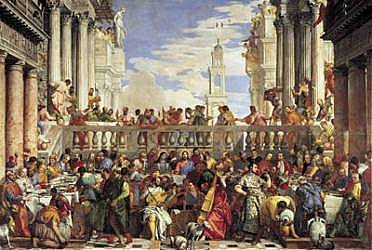
Veronese (Paolo Caliari), The Wedding Feast at Cana, 1562/63
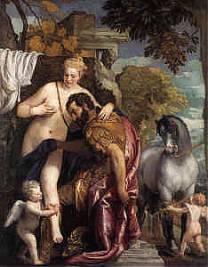
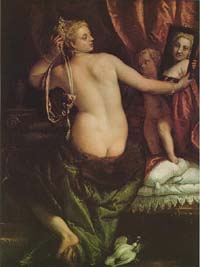
(Left) Veronese (Paolo Caliari), Mars and Venus United by Love, 1576-84
(Right) Veronese (Paolo Caliari), Venus at her Toilette, ca. 1582
Duryea identifies several religious paintings by Veronese,
but the context of the quote below would suggest more a
painting like these mythic paintings of Venus [Aphrodite].
- Cather on Hedger's interpretation of Eden Bower:
- "He thought of that body as never having been clad, or as having worn the stuffs and dyes of all the centuries of his own. And for him she had no geographical associations; unless with Crete, or Alexandria, or Veronese's Venice. She was the immortal conception, the perennial theme" ("Coming, Aphrodite!" YBM 22 [Crane C54]).

Clara Montalba, Gondola with Flowers, 1887
The unsigned painting of Venice with a gondola in
foreground and
the dome of Santa Maria della Salute in the background may have
have been like this one of a Venetian ceremony in the Grand Canal
--"Gondola with
Flowers" by Clara Montalba, a late-nineteenth
century artist
known for her Venetian paintings, as were other artists.
- "An unsigned scene of a gondola on the Grand Canal in Venice hangs in Cather childhood-home. The dome of Santa Maria della Salute is in the background," according to Duryea.

Related Resources:
Death Comes for the Archbishop
Comments/Suggestions: knichols11@cox.net
Updated: 12-14-12


